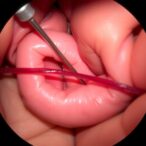
In a groundbreaking correction published recently in Cell Death Discovery, researchers have unveiled compelling evidence that the chemical chaperone 4-phenylbutyric acid (4-PBA) can effectively rescue molecular and cellular defects caused by mutations in the COL3A1 gene, which are known to underlie vascular Ehlers-Danlos Syndrome (vEDS). This revelation not only sheds new light on the intricate molecular pathology of this often-devastating connective tissue disorder but also opens promising therapeutic avenues that may revolutionize patient care and management in the near future.
Vascular Ehlers-Danlos Syndrome is a rare heritable connective tissue disorder characterized primarily by severe fragility of blood vessels and hollow organs, leading to life-threatening vascular ruptures and complications. The disorder stems largely from mutations in the COL3A1 gene, which encodes type III collagen, a critical structural protein that maintains the integrity and elasticity of arterial walls and other tissues. Mutations in COL3A1 typically result in improperly folded procollagen molecules, prompting widespread cellular stress, impaired collagen deposition, and a breakdown of the extracellular matrix architecture fundamental to vascular resilience.
The study elucidates how 4-PBA, a low molecular weight aromatic fatty acid and a well-known chemical chaperone, alleviates these molecular defects through its capacity to assist in protein folding and reduce endoplasmic reticulum (ER) stress within affected cells. ER stress is increasingly implicated in the pathogenesis of numerous genetic collagenopathies, and its mitigation represents a strategic target to restore cellular homeostasis and proper protein synthesis. The researchers’ demonstration that 4-PBA significantly ameliorates ER stress markers and corrects defective collagen synthesis in vEDS mutant cells is remarkable and provides a biologically plausible intervention pathway.
Mechanistically, 4-PBA is believed to act by stabilizing nascent polypeptides, enhancing their correct folding, and facilitating their export from the ER to the Golgi apparatus, preventing the accumulation of misfolded collagen chains that would otherwise trigger cellular dysfunction. Such molecular rectification not only rescues the intracellular trafficking but also increases the secretion of functional type III collagen, thus potentially restoring the mechanical competence of vascular tissues. The researchers quantitatively assessed both intracellular retention of collagen and extracellular matrix deposition, demonstrating notable improvements post-treatment.
Importantly, this research employed patient-derived fibroblasts harboring varying pathogenic COL3A1 mutations to ensure the translational validity of their findings. Fibroblasts — the primary collagen-producing cells in connective tissue — offer a highly relevant in vitro model for studying vEDS pathophysiology. Using advanced molecular assays, including immunoblotting, immunofluorescence microscopy, and quantitative PCR, the team decisively showed that 4-PBA reversed hallmark cellular aberrations, including reduced collagen secretion and heightened ER stress indicators such as BiP/GRP78 and CHOP expression.
The study’s correction clarifies critical aspects of the initial findings, emphasizing reproducibility and transparency. While the therapeutic implications hold promise, the authors wisely caution about the complexity of translating in vitro benefits into clinical outcomes. Pharmacokinetics, optimal dosing regimens, tissue-specific responses, and potential side effects of chronic 4-PBA use remain pivotal questions to address in forthcoming preclinical and clinical trials.
Further exploring the implications, these cellular corrections may attenuate the downstream consequences of vEDS mutations—namely, vascular fragility and propensity for rupture. By restoring collagen homeostasis at the molecular level, the extracellular matrix structure might regain some integrity, potentially delaying or preventing life-threatening vascular events. Such an approach contrasts with current disease management strategies, which mainly involve symptomatic treatment, blood pressure control, and surgical interventions rather than molecular correction.
This study also aligns with a growing body of research highlighting chemical chaperones as versatile tools in tackling protein misfolding diseases. The successful application of 4-PBA in vEDS models augurs well for similar strategies in other collagen-related disorders and ER-stress-associated pathologies. Developing targeted therapies that correct the underlying molecular anomalies rather than solely managing clinical manifestations is the future of precision medicine.
Moreover, the authors delve into the intricate cellular responses to COL3A1 mutations beyond collagen misfolding. They illustrate how mutant collagen strands induce a chronic unfolded protein response (UPR) that compromises cellular viability and function. The findings reveal a nuanced picture of vEDS pathogenesis where sustained UPR activation exacerbates tissue degradation. 4-PBA’s ability to quell this response highlights its dual therapeutic potential: both facilitating protein folding and tempering maladaptive stress pathways.
The correction note further refines the methodological approaches, underscoring rigorous controls and emphasizing the need for standardized protocols when assessing chemical chaperone efficacy. Given the heterogeneity of COL3A1 mutations and their variable phenotypic consequences, personalized approaches will be necessary to tailor treatment strategies. The capacity of 4-PBA to broadly restore molecular function across different mutation types instills optimism but also urges careful stratification in future clinical trials.
Another compelling dimension is the possibility of combining 4-PBA treatment with other pharmacological agents or gene therapies to achieve synergistic benefits. Addressing both the production and stability of collagen may yield comprehensive therapeutic regimens that significantly improve quality of life and prognosis for vEDS patients. The correction reinforces the idea that an integrated cellular and molecular intervention strategy is essential in complex genetic disorders.
As the scientific community continues to unravel the molecular pathophysiology of vEDS, this research epitomizes the power of translational medicine bridging bench to bedside. By leveraging chemical chaperones like 4-PBA, which are already approved for other clinical indications, repurposing them for rare genetic disorders could expedite the availability of effective treatments. This pragmatic approach may bypass traditional hurdles in drug development timelines, thereby benefitting patients more rapidly.
In conclusion, the corrected findings represent a significant milestone in understanding and potentially treating vascular Ehlers-Danlos Syndrome at its molecular roots. They highlight 4-phenylbutyric acid as a promising candidate for rescuing defective collagen production caused by COL3A1 mutations and mitigating the detrimental cellular stress responses that contribute to disease progression. While challenges remain in translating these discoveries clinically, the prospects for innovative, targeted therapies are undeniably brighter, renewing hope for those affected by this challenging disorder.
Subject of Research: Molecular and cellular defects caused by COL3A1 mutations in vascular Ehlers-Danlos Syndrome and therapeutic effects of 4-phenylbutyric acid.
Article Title: Correction: The chemical chaperone 4-phenylbutyric acid rescues molecular cell defects of COL3A1 mutations that cause vascular Ehlers Danlos Syndrome.
Article References:
Omar, R., Lee, M.A., Gonzalez-Trueba, L. et al. Correction: The chemical chaperone 4-phenylbutyric acid rescues molecular cell defects of COL3A1 mutations that cause vascular Ehlers Danlos Syndrome. Cell Death Discov. 11, 250 (2025). https://doi.org/10.1038/s41420-025-02529-2
Image Credits: AI Generated
Tags: 4-Phenylbutyric acid therapeutic potentialchemical chaperones in medicineCOL3A1 gene mutationsconnective tissue disorder managementconnective tissue disorders researchextracellular matrix integrityinnovative therapies for genetic disordersmolecular pathology of vEDSprotein folding and cellular stressrecent advancements in medical researchVascular Ehlers-Danlos Syndrome treatmentvascular fragility and complications



